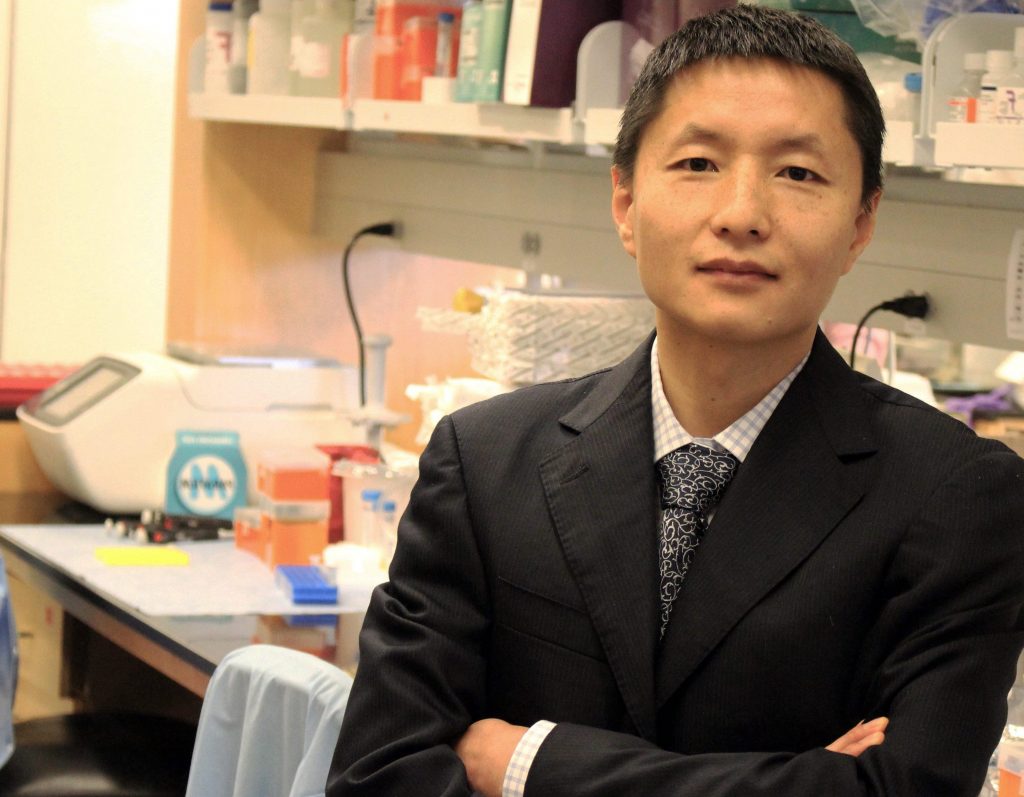A newly developed immunotherapy that simultaneously uses modified immune-fighting cells to home in on and attack two antigens, or foreign substances, on cancer cells was highly effective in mice implanted with human neuroblastoma tissue, report researchers from the UNC Lineberger Comprehensive Cancer Center. The dual targeting restricted regrowth of the tumor as well as prevented the neuroblastoma cells from evading the attacking immune cells.
The research findings appeared Sept. 23, 2021, in Nature Cancer.
Neuroblastoma is a cancer of immature nerve cells and occurs mainly in children younger than six years of age. The tumors are typically found on top of adrenal glands but can also develop in the abdomen, chest, neck, pelvis, and bone. Approximately 500 to 1,000 cases are diagnosed annually in the United States.

“Tumor cells are characterized by a mixed expression of antigens, and we engineered dual immune-system T cells to maximize their capacity to prevent tumors from evading detection by the immune system,” said Hongwei Du, PhD, a postdoctoral fellow at UNC School of Medicine. “Furthermore, the modified T cells were also able to receive important signals, which is somewhat unique as there have been many challenges in getting certain types of immunotherapies to overcome the unfriendly tumor environment found in solid tumors.”
The researchers utilized CAR-T cell (chimeric antigen receptor-T cell) immunotherapy, which involves harvesting immune-system T cells from a patient and genetically re-engineering them in the lab to recognize targets on the surface of cancer cells when they are reinfused into patients.
Specifically, the scientists coupled the recognition of two antigens expressed by the tumor cells with the combination of two key co-stimulatory molecules: CD28, a protein expressed on T cells after early activation, and 4-1BB, an important co-stimulatory protein that is involved in T-cell survival and memory formation. Both CD28 and 4-1BB have been shown to be equally effective in clinical studies in patients with blood-borne cancers when used individually. However, the combination of CD28 and 4-1BB co-stimulation appears to be critical in solid tumors. Research efforts by Du resulted in ways to deliver both signals efficiently.

The scientists first looked at neuroblastoma cells in the laboratory to see how they responded to a combined immune cell attack. Given the positive results of the lab studies, the researchers then looked at mice implanted with neuroblastoma to see how they would respond to co-stimulation by CD28 and 4-1BB modified T cells. Indeed, the co-stimulatory cells were very effective in reducing cancer in mice bearing large numbers of neuroblastoma tumors.
“We know that certain CAR-T therapies are safe for patients with solid tumors, but so far treatments have not led to the degree of tumor regression we would like to see,” said Gianpietro Dotti, MD, professor in the UNC School of Medicine Department of Microbiology and Immunology and co-leader of the Immunology Program at UNC Lineberger. “We ultimately designed a strategy that simultaneously addresses the most challenging tasks in solid tumors, such as generating CAR-T cells that rapidly eliminate the tumor and persist in controlling tumor growth. Furthermore, our system prevents tumor recurrence.”

If this therapeutic approach is as promising in people as it has been in mice, the researchers said targeting three, four or more antigens expressed by tumor cells could be even more effective. They will proceed with caution as over-stimulation could exponentially increase side-effects. To counter this, the researchers can use a ‘safety switch’ technology that Dotti, Barbara Savoldo, MD, PhD, professor of pediatrics and assistant director of the UNC Lineberger Immunotherapy Program, and others developed to regulate the level of CAR-T generated stimulation.
“We are currently implementing clinical studies to look at several potential single targets,” said Dotti. “If these studies prove that the therapies are safe, we’ll then progress to the next logical step, which is looking to see if our therapy is effective against a combination of targets.”
In addition to Du, Dotti and Savoldo, the paper’s other authors at UNC include Koichi Hirabayashi, MD, Yang Xu, PhD, Peishun Shou, PhD, Xin Zhou, PhD, Elisa Landoni, Chuang Sun, PhD, and Yuhui Chen, PhD.
Disclosures
This work was funded in part by NCI grants R01-CA193140-03 and R01-CA243543-01 from the National Cancer Institute; grant W81XWH-18-1-0441 from the Department of Defense (USA) and the Vicky Amidon Innovation Grant in Lung Cancer Research from the Lung Cancer Initiative of North Carolina; the UNC Small Animal Imaging Facility at the Biomedical Imaging Research Center; the Microscopy Services Laboratory at Department of Pathology; the Laboratory Medicine and the Flow Cytometry Core Facilities are supported in part by an NCI Cancer Center Core Support grant to the UNC Lineberger Comprehensive Cancer Center, grant P30-CA016086-40.
Competing interests
Dotti is a paid consultant for Bellicum Pharmaceuticals, Tessa Therapeutics and Catamaran and reports receiving commercial research grants from Cell Medica and Bluebird Bio; Savoldo is a paid consultant for Tessa Therapeutics; Dotti and Du filed a patent for the CAR targeting B7-H3. No other competing interests were disclosed by the other authors.
